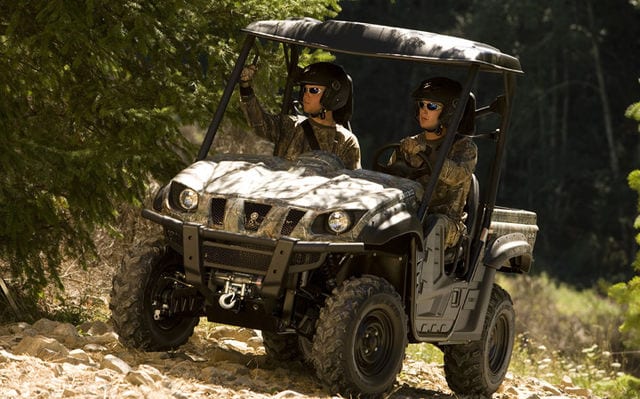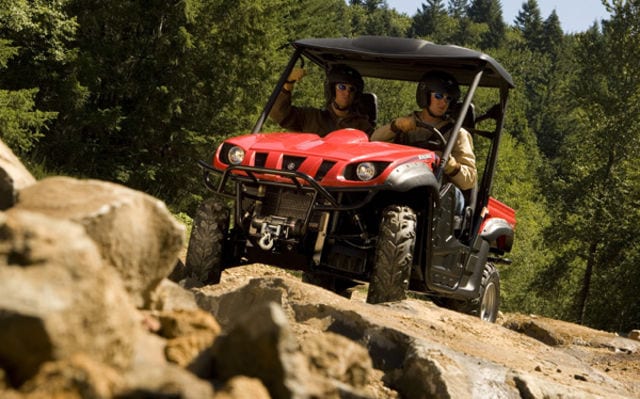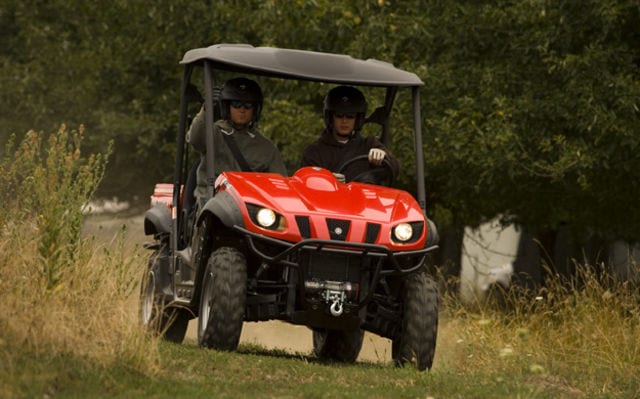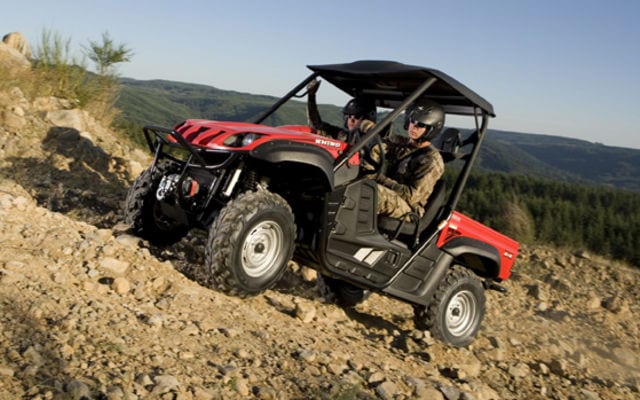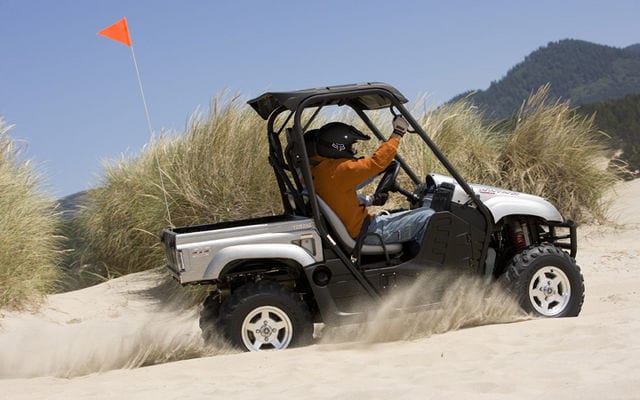You won’t have to look far to find a Side x Side vehicle these days. They’re showing up at hunting camps, riding areas, trail systems, and every other place in the country that ATVs have traditionally held a foothold. Part of their popularity is from riders who simply do not feel comfortable on an ATV, they want a vehicle that is more familiar to operate and can take a passenger or two, or they simply need the carrying capacity of a bed and the working capabilities a Side x Side offers. The factories that got into the Side x Side game early like Polaris, Arctic Cat, and Yamaha have been rewarded well for their foresight, and as more competitors jump into the game, nearly every manufacturer is battling for position in the market, trying to carve out a niche of their own.
The Side x Side market has been evolving rapidly in the past few seasons, and while some brands have chosen to go with the more traditional working aspect of the vehicles, others have designed theirs for performance. Yamaha is one such company. While they do pay homage to the working capabilities of their wildly popular Rhino, they are especially proud of its sporty side, and true to their nature, the Blue Crew has never been afraid to innovate. They were the first to offer a highly competitive, mass produced 4 stroke motocross bike, the first to offer a multitude of unique ATVs, the Banshee, the Raptor 660 and 700, the first true factory race quad, the YFZ 450, the first with power steering, the Grizzly 700, and the list goes on. It’s simply their nature to take a different path, and the Rhino joined the Yamaha family in the same manner. No product can survive forever without evolving though, and the Rhino was due for a few changes. Improved drivability, reduced noise and vibration, and -improved comfort for the driver and pas—senger were the goals for the ’08 Rhino, and we’ve been putting one to the test recently.
STRAP YOURSELF IN!
Whether it’s a motorcycle, an ATV, or a Rhino, before anybody ever starts a vehicle, they hop on and check out the controls. The first thing most people will notice about the 2008 Rhino is the addition of doors! Yamaha felt it was time to add doors to the Rhino, and for several reasons. Let’s face it, the Rhino is a performance vehicle, and even if it spends its days chasing cows around the farm, the absolute fun of driving it is going to overtake most people sooner or later, and they’re going to pretend it’s a Baja buggy! We don’t blame them. The Rhino is a blast to drive, and we’ve pushed it through the woods and dunes, but you must also respect it. The problem is, a few individuals have overestimated their own driving abilities, and have managed to get into trouble. Instinctually, a few have stuck their leg out, and that is a big mistake on a Side x Side. The doors were designed to make that impossible, and they close and latch securely. A second job for the doors was to help protect the driver and passenger from mud and water thrown from the front tires, and they do this very well. The new doors provide great splash protection, and even though they don’t technically seal the compartment, they definitely keep water and flying mud off you much better. They work very well for both jobs.
Once inside the Rhino and strapped into the seat, the driver will notice a new steering wheel. The new wheel has a slightly smaller diameter, raised grip areas, and looks much sportier. It definitely fits the Rhino sport image. The center of the compartment has been redesigned as well for a new air intake tract, an automotive style parking brake instead of the short lever found on previous models, and as requested by many owners, cup holders! In the center of the dash is an easy to read digital display, which -appears to be nearly identical to the one found on the Grizzly 700. We scrolled through the functions, and the new display features a trip meter, speedometer and odometer, gear selection, fuel level, 4WD, 2WD, indicator lights, and even battery voltage. Should your Rhino need to head to the shop, it also has a self-diagnostic function as well.
A NEW ENGINE & EFI
Engine design is an immensely costly and time consuming thing. As a result, when a company launches a new engine, and it’s proven over time, they want to utilize the base design as much as possible to recoup their investment. In the case of the Rhino, the old 660 engine had served it well, but it was time for a change, and the logical choice was the power plant from the Grizzly. This also meant EFI! The new Rhino engine is now a 686cc, 4-Stroke single cylinder and single overhead cam design, and features liquid cooling with an on-demand fan. The top end of the engine is taken directly from the mighty Raptor 700, and that’s fine with us. The Raptor 700 is an awesome sport quad, and it has never let us down. One thing that makes the top end work so well is a roller rocker arm system, which reduces drive train friction while allowing the engine to rev more freely. Inside the specially coated aluminum cylinder is a forged piston, and just like the Grizzly 700, the Rhino engine gets a slightly heavier crank with more beef at each end of the connecting rod to compensate for the added loads of utility vehicles. The heavier crank also helps reduce vibration as well, which was another goal of the engineering team, however, the best feature of the new engine package is the electronic fuel injection system. The fuel injection system performs extremely well at all temperatures and elevations, and delivers a nice, crisp throttle response throughout the power band. Forget finding a choke, because an EFI system doesn’t need one. It will take several readings of both the air temperature and pressure, and existing engine conditions, and mist just the right amount of fuel through the 41mm Mikuni throttle body needed to maintain optimum power. We love it!
Changes to the Rhino engine don’t stop at simply a heavier crank and fuel injection however. Since the new engine would be cranking out more horsepower, a larger radiator was included, and to help with cooling, a full shroud ducts air across the entire core. As an added bonus, the shroud also helps contain fan noise as well, again meeting one of the design goals. Rubber engine mounts are used to hold the -engine in the chassis, to isolate vibration, and to reduce noise. Most Side x Side vehicles are a little louder than their ATV cousins for several reasons. Engine placement, air intake location, and exhaust -design are all contributing factors, but also the extensive bodywork and cargo bed have vastly more reflective surfaces to send that noise back to the driver and passenger as well. To help contain that noise on the Rhino 700, the engineering crew redesigned the air intake tract, and the exhaust system. Now the filter and air box are found high inside the front nose piece, and clean air is ducted to the engine from there. The new air box location is also very easy to get to, and both the cover and the foam filter element are easily removed with no tools. There’s no reason not to clean it now! At the opposite end of the engine, the Rhino gets an all new stainless steel exhaust system. The advantage of the new exhaust system is not only better corrosion protection, but reduced vibration, and reduced noise as well, and this was accomplished through the use of rubber mounts, and a new spherical slip joint.
TIME to RIDE
There are a couple extra things to do before getting underway with the Rhino. Close the door and fasten the seat belt! After that, simply hold the brake, turn the key, and when the engine easily spins to life, slip it into either, hi, low, or reverse. Yamahas Ultramatic transmission, (which is Yamahas version of a CVT type system) will take care of itself. The Yamaha people are especially proud of the Rhino transmission, which now features 6 discs, and Yamahas Sprag clutch. The advantage is, the Sprag clutch works in one direction only, and is designed to assist in control on downhill descents by allowing engine braking to help hold the vehicle. Shifting between 2wd, 4wd, and 4wd with differential lock is also easy, and all the driver needs to do is hit the button on the dash. Just be sure you are stopped, or nearly stopped when engaging the front wheels! Under ordinary operation, the Rhino can conquer most obstacles in 2wd, however, when the trail gets a little slippery or snow covered, press the button, and 4wd can be activated. If that still isn’t enough, simply hit the 4WD Differential lock button. Beyond that, you need a winch.
We’ve been through the desert, the dunes, and the woods in our Rhino, and regardless of where we are, the one constant is how fun it is to drive, and how easy it is to terrify a passenger. For our initial Rhino 700 ride, we chose a woods ride with steep, rocky hills, and climbs that would test both the Rhino, and our nerve. We also would be crossing rivers, hitting fast logging roads, and winding through the trees. It would be an excellent test in every respect. The Rhino had no problem winding through the trees, but the one difference between a Side x Side vehicle and a traditional ATV is when it comes time to turn around. Instead of simply circling the tree like we would on a quad, a Side x Side driver usually has to back up, and make a 3 point turn. You’re certainly not going to get off and muscle it around! River crossing were no problem, and the Rhino easily crossed slippery rocks and logs, and the new doors did a good job of keeping water flow to a minimum. When it came time for hill climbing, the Rhino was ready, but we’re not sure we were. The trail system we were riding featured many steep, rocky climbs that wound between trees, and once there, an equally harrowing descent. We had to try, and the Rhino clawed at the ground, bounced across roots and rocks, and generally fought its’ way to the top. It was a great feeling of accomplishment actually, but the arrow to the spine realization that the descent would be equally as tricky quickly overcame any -celebration. To make matters worse, it was time to switch seats, and for lifelong ATV riders, giving up the controls to another driver and merely hanging on for the ride is somewhat like bull riding. It feels very much like it’s just a matter of time before you’re thrown to the dirt. Luckily, the Yamaha people had updated both the brake system, and the CV shafts on the ’08 Rhino, and we fully appreciate the disc brakes on all wheels. Between the engine braking, and the new disc brakes, we had no control problems on our way down the hills as well. We began to see the full capabilities of the Rhino.
OUR WISH LIST
The Rhino is an amazing vehicle and can go places we never imagined a utility vehicle could get to.We’re always looking for ways to improve any vehicle however, and there are a couple things we would like change on the Rhino. The passenger needs a better hand hold. At their left hand there is a bar and grip, very much like the control lever on a helicopter, and it works fine for the left hand. However, there is no right hand grip, and any similar lever on the right would almost certainly get in the way when -trying to enter or exit the vehicle, and to make matter worse, would probably encourage riders to put a hand out should things get a little tipsy. The cardinal rule of any Side x Side is the same for any ride at DisneyWorld: Keep your hands and feet inside the vehicle at all times! Yamahas’ solution for a right hand grip was to attach a tie-down strap to the left hand lever. It’s almost back to the bull riding scenario, but what they really need is a small grip above the glove compartment. As the chassis is built now however, there is no structural member to attach it to. We would also change the passenger handhold on the roll cage front down tube to a rubber bolt on part as well. If a passengers head were to bounce off the hard steel handle in place now, it will certainly leave a welt, and although we always wear a helmet, many Rhino riders do not!
From the drivers’ side, although we love the new steering wheel, we would like to try a steering gear rack with a more aggressive -ratio. As it is offered now, the driver must turn the wheel 2-1/2 complete revolutions to turn the front wheels from full left to full right, and that feels a little slow, almost like the tires are not keeping up with the steering wheel. A different gear ratio would make the vehicle feel a little more precise. Another item we would change is the pedal layout. The current design has the brake lever closer to the seat than the throttle pedal, and that means to move from the throttle to the brake, a driver often times must lift his foot from the floor, and transfer to the brake. That is highly unusual in a performance vehicle, where the brake and throttle are on the same plane, and a driver never removes his foot from the contact point on the vehicle floor. We’re extremely happy to find the electronics tray and air filter under the front hood, but the electronics tray cover should have been -designed so that it did not have a raised lip to hold water and mud on top, where it can work its way down into the electronics center.
RHINO EVOLUTION
There is very little not to like with the new Rhino 700. It runs excellent, has good work capabilities, it’s very reliable, and is simply a blast to drive. With the addition of EFI, its cold weather capabilities have been improved, and the other changes Yamahas made have all worked to improve the package. There is very little terrain it cannot conquer, and we always want one in the garage!
For more information on the above mentioned models, please visit the Yamaha Motor Website
More from Yamaha on ATV Trail Rider :
Yamaha ATV Models – Yamaha UTV Models – Yamaha ATV Reviews – Yamaha UTV Reviews


